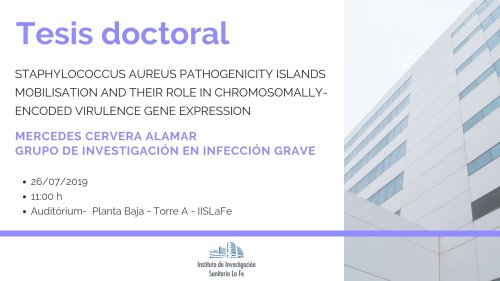Events
STAPHYLOCOCCUS AUREUS PATHOGENICITY ISLANDS MOBILISATION AND THEIR ROLE IN CHROMOSOMALLY-ENCODED VIRULENCE GENE EXPRESSION
Auditórium. Torre A.
11:00 horas
Auditórium. Torre A.
11:00 horas

Summary
Staphylococcus aureus is a Gram-positive opportunistic bacterium that colonises the skin and mucosae of human beings and several animal species. S. aureus rapidly adapts to different niches in diverse hosts and to archive the infection, S. aureus encodes for a myriad of virulence factors, such as adhesins, immune evasions proteins or toxins. These virulence factors are mainly encoded in Mobile Genetic Elements (MGEs) which horizontal transmission is fundamental to the evolution and plasticity of S. aureus.
This doctoral thesis is focused on the study of S. aureus MGEs, mainly in bacteriophages and S. aureus pathogenicity islands (SaPIs), and their horizontal gene transfer (HGT) due to their fundamental role regarding adaptation and pathogenicity. SaPIs are integrated in the chromosome under the control of the repressor Stl but they can be horizontally transferred at a high frequency due to certain bacteriophages. We report the dissemination mechanism of SaPIs mediated by endogenous phages in clinical strains from diverse origins. We consider this finding important since the use of antibiotics used in clinical practice such as b-lactam or fluoroquinolones can induce the SOS response. This response activates the prophage and promote the spread of SaPIs and staphylococcal virulence genes as an unintended consequence.
To archive SaPI mobilisation is necessary the interaction of one SaPI protein (repressor Stl) and a phage protein (derepressor). The interaction is highly specific and until now, only four phage de-repressors have been identified We found phage Sa2mw as the endogenous phage able to induce SaPImw2 and we characterized a new de-repressor able to interact with SaPImw2 repressor. The de-repressor is a hypothetical phage protein with DUF3113 domain.
SaPIs are not merely virulence gene carriers, they have developed different strategies that make them critical to the S. aureus evolution. SaPIs interfere with phage reproduction and also play a role in bacterial evolution by mediating the transfer of chromosomally-encoded virulence genes. In addition, they are also a key force driving phage evolution and ecology. Due to this multifunctionality shown by the SaPIs, it is likely that they can develop other functions which are important to bacteria. In this study, we explored the hypothesis that SaPIs are involved in the regulation of chromosomal genes expression. For this purpose, we performed a genome-wide transcriptional analysis using RN450 and its derivatives strains with presence and absence of SaPIs. We conclude that SaPIs can control the expression of chromosomal virulence genes. We then focused on the regulation mechanism of the virulence operon crtOPQMN. This operon codifies the carotenoid staphyloxanthin (STX) but also plays an important role in the resistance. to innate immune system. Two SaPI proteins, exclusively found in SaPIs, were identified as being responsible for STX expression through an antitermination regulatory mechanism.
Import Outlook Calendar Import Google Calendar








